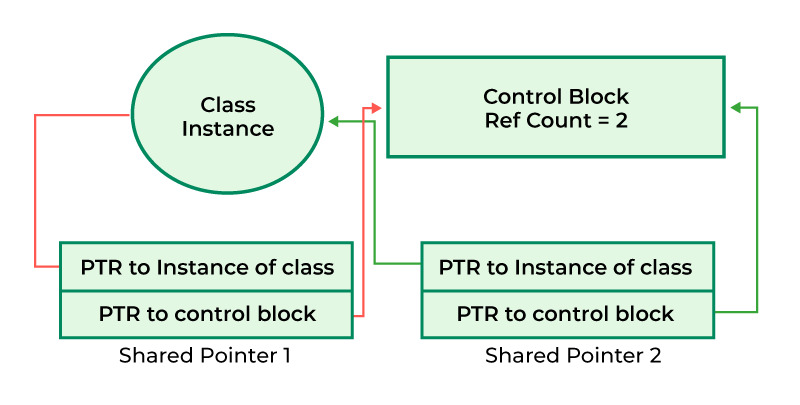std::shared_ptr是C++11中引入的智能指針之一。與簡單指針不同,它有一個關聯的控製塊,用於跟蹤托管對象的引用計數。此引用計數在指向同一對象的 shared_ptr 實例的所有副本之間共享,確保正確的內存管理和刪除。
先決條件: C++ 中的指針,C++ 中的智能指針.

C++ 中的共享指針
std::shared_ptr 的語法
T 類型的 shared_ptr 可以聲明為:
std::shared_ptr <T> ptr_name;
shared_ptr對象的初始化
我們可以使用以下方法初始化shared_ptr:
1. 使用新指針進行初始化
shared_ptr<T> ptr (new T());
shared_ptr<T> ptr = make_shared<T> (new T());
2.使用現有Pointer進行初始化
shared_ptr<T> ptr(already_existing_pointer);
shared_ptr<T> ptr = make_shared(already_existing_pointer);
shared_ptr的成員方法
以下是與shared_ptr相關的一些成員:
| 方法 | 說明 |
|---|---|
| reset() | 將 std::shared_ptr 重置為空,釋放托管對象的所有權。 |
| use_count() | 返回當前引用計數,指示有多少個 std::shared_ptr 實例共享所有權。 |
| unique() | 檢查是否隻有一個 std::shared_ptr 擁有該對象(引用計數為 1)。 |
| get() | 返回指向托管對象的原始指針。使用此方法時要小心。 |
| 交換(shr_ptr2) | 交換兩個 std::shared_ptr 實例的內容(所有權)。 |
std::shared_ptr 的示例
示例 1:
C++
// C++ program to demonstrate shared_ptr
#include <iostream>
#include <memory>
using namespace std;
class A {
public:
void show() { cout << "A::show()" << endl; }
};
int main()
{
// creating a shared pointer and accessing the object
shared_ptr<A> p1(new A);
// printting the address of the managed object
cout << p1.get() << endl;
p1->show();
// creating a new shared pointer that shares ownership
shared_ptr<A> p2(p1);
p2->show();
// printing addresses of P1 and P2
cout << p1.get() << endl;
cout << p2.get() << endl;
// Returns the number of shared_ptr objects
// referring to the same managed object.
cout << p1.use_count() << endl;
cout << p2.use_count() << endl;
// Relinquishes ownership of p1 on the object
// and pointer becomes NULL
p1.reset();
cout << p1.get() << endl;
cout << p2.use_count() << endl;
cout << p2.get() << endl;
/*
These lines demonstrate that p1 no longer manages an
object (get() returns nullptr), but p2 still manages the
same object, so its reference count is 1.
*/
return 0;
}輸出
0x1365c20 A::show() A::show() 0x1365c20 0x1365c20 2 2 0 1 0x1365c20
示例 2:
C++
// C++ program to illustrate the use of make_shared
#include <iostream>
#include <memory>
using namespace std;
int main()
{
// Creating shared pointers using std::make_shared
shared_ptr<int> shr_ptr1 = make_shared<int>(42);
shared_ptr<int> shr_ptr2 = make_shared<int>(24);
// Accessing the values using the dereference operator
// (*)
cout << "Value 1: " << *shr_ptr1 << endl;
cout << "Value 2: " << *shr_ptr2 << endl;
// Using the assignment operator (=) to share ownership
shared_ptr<int> shr_ptr3 = shr_ptr1;
// Checking if shared pointer 1 and shared pointer 3
// point to the same object
if (shr_ptr1 == shr_ptr3) {
cout << "shared pointer 1 and shared pointer 3 "
"point to the same object."
<< endl;
}
// Swapping the contents of shared pointer 2 and shared
// pointer 3
shr_ptr2.swap(shr_ptr3);
// Checking the values after the swap
cout << "Value 2 (after swap): " << *shr_ptr2 << endl;
cout << "Value 3 (after swap): " << *shr_ptr3 << endl;
// Using logical operators to check if shared pointers
// are valid
if (shr_ptr1 && shr_ptr2) {
cout << "Both shared pointer 1 and shared pointer "
"2 are valid."
<< endl;
}
// Resetting a shared pointer
shr_ptr1.reset();
}輸出
Value 1: 42 Value 2: 24 shared pointer 1 and shared pointer 3 point to the same object. Value 2 (after swap): 42 Value 3 (after swap): 24 Both shared pointer 1 and shared pointer 2 are valid.
示例 3:使用 std::shared_ptr 實現鏈表
C++
#include <iostream>
#include <memory>
using namespace std;
// Define a singly linked list node
struct Node {
int data;
shared_ptr<Node> next;
Node(int val)
: data(val)
, next(NULL)
{
}
};
class LinkedList {
public:
LinkedList()
: head(NULL)
{
}
// Insert a new node at the end of the linked list
void insert(int val)
{
shared_ptr<Node> newNode = make_shared<Node>(val);
if (!head) {
head = newNode;
}
else {
shared_ptr<Node> current = head;
while (current->next) {
current = current->next;
}
current->next = newNode;
}
}
// Delete a node with a given value from the linked list
void del(int val)
{
if (!head) {
return;
}
if (head->data == val) {
head = head->next;
return;
}
shared_ptr<Node> current = head;
while (current->next
&& current->next->data != val) {
current = current->next;
}
if (current->next && current->next->data == val) {
current->next = current->next->next;
}
}
// Traverse and print the linked list
void Print()
{
shared_ptr<Node> current = head;
while (current) {
cout << current->data << " -> ";
current = current->next;
}
cout << "NULL" << endl;
}
private:
shared_ptr<Node> head;
};
int main()
{
LinkedList linkedList;
// Insert nodes into the linked list
linkedList.insert(1);
linkedList.insert(2);
linkedList.insert(3);
// Print the linked list
cout << "Linked List: ";
linkedList.Print();
// Delete a node and print the updated linked list
linkedList.del(2);
cout << "Linked List after deleting 2: ";
linkedList.Print();
return 0;
}輸出
Linked List: 1 -> 2 -> 3 -> NULL Linked List after deleting 2: 1 -> 3 -> NULL
相關用法
- C++ sin()用法及代碼示例
- C++ sinh()用法及代碼示例
- C++ scalbn()用法及代碼示例
- C++ scalbln()用法及代碼示例
- C++ sqrt()用法及代碼示例
- C++ strtod()用法及代碼示例
- C++ strtol()用法及代碼示例
- C++ strtoll()用法及代碼示例
- C++ strtoull()用法及代碼示例
- C++ srand()用法及代碼示例
- C++ strcpy()用法及代碼示例
- C++ strncpy()用法及代碼示例
- C++ strcat()用法及代碼示例
- C++ strncat()用法及代碼示例
- C++ strcmp()用法及代碼示例
- C++ strncmp()用法及代碼示例
- C++ strchr()用法及代碼示例
- C++ strspn()用法及代碼示例
- C++ strcspn()用法及代碼示例
- C++ strpbrk()用法及代碼示例
- C++ strrchr()用法及代碼示例
- C++ strstr()用法及代碼示例
- C++ strtok()用法及代碼示例
- C++ strlen()用法及代碼示例
- C++ strerror()用法及代碼示例
注:本文由純淨天空篩選整理自yash_cse_21大神的英文原創作品 shared_ptr in C++。非經特殊聲明,原始代碼版權歸原作者所有,本譯文未經允許或授權,請勿轉載或複製。
